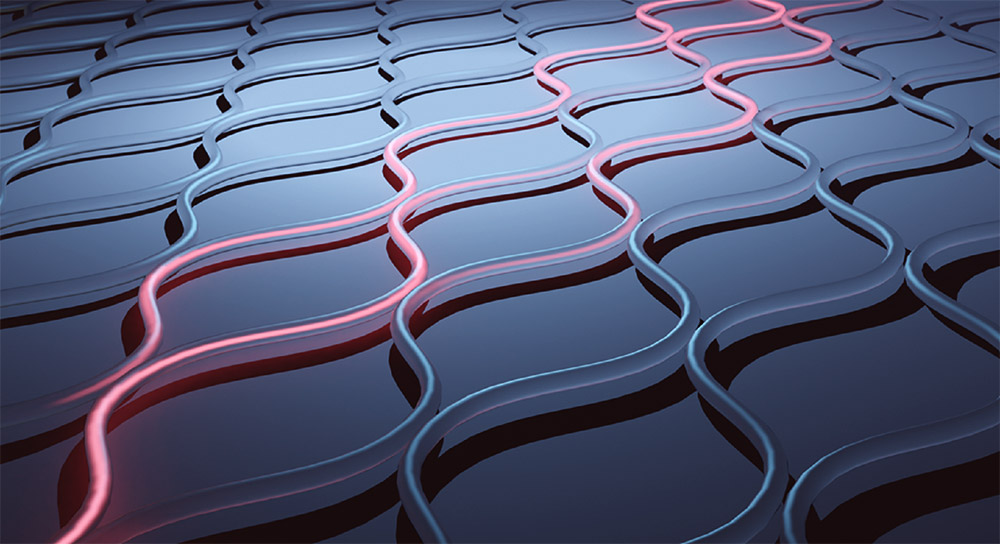Bonded light: Physicists have been able to capture light with the help of a new type of trap – thus demonstrating a physical effect that has not been proven experimentally. In this case, the special structure prevents wave propagation, although the light spectrum lies outside the spectral range of the interference pattern. It was previously not clear whether the light chain is even possible by the so-called Anderson localization of such a group – and this has now been demonstrated.
Phenomena such as refraction and diffraction of light show that light and other radiation can be affected by certain materials. Such interactions can change the direction, phase, polarization, or wavelength of light. In special metamaterials and photonic crystals, physicists have even succeeded in blocking light to stop or the speed of its development To infinity To speed up.
Anderson localization: fixed waves
Another way to deal with light and other waves is what is known as Anderson localization. They are based on a theoretical prediction made by the American physicist Philip Anderson in 1958. According to this, the disruptive effect of some structures – the so-called turbulent systems – can suddenly stop freely moving electrons and other quantum particles. In the case of electrons, this suddenly turns a conductor into an insulator.
Since then, this Anderson localization has also been demonstrated for various forms of radiation and sound waves. However, there appears to be a limitation: these wave traps only work if the lattice size of the manipulated structure matches the spectrum and therefore the wavelength of the radiation. “Experimentally, Anderson’s localization has always been limited to the spectral range of the disturbance,” Alex Dikoboltsev of the Technion in Haifa and colleagues explain.
Is this also possible for the “invisible” trap?
But physicists have now broken that limit: they’ve proven that “invisible” structures of light because they lie outside its spectrum can also pick up waves. Dikoboltsev and his team had already theoretically predicted this in 2019, and now, together with colleagues from the University of Rostock, they have also managed to prove it experimentally.
For their experiment, the physicists first built a photonic structure that acts as a perturbative system—a light trap. “To do this, we interconnected kilometers of optical glass fibers in such a way that the propagation of light in these fibers simulates the movement of electrons in the irregular materials,” explains co-author Sebastian Weidmann of the University of Rostock. The researchers then sent beams of radiation through this system, whose wave numbers were significantly higher or lower than the spectral size of the interfering structure.
Successful empirical proof
The result: “We can clearly see that the light waves are confined to small spatial regions even if the turbulence is practically invisible to them,” Weidemann reports. The wave beams were held in place, showing clear evidence of Anderson localization. “We have demonstrated experimentally for the first time that Anderson localization can occur completely outside the spectral range of the disorder,” say the physicists.
According to their analysis, this new effect comes about through virtual transitions: “By interacting several times in a row with the almost invisible turbulence of light waves, an unexpectedly strong effect can arise that pushes even these light waves to Anderson localization,” Dikoboltsev explains. “As a result, waves of any wave number, even outside the turbulence spectrum, can experience Anderson localization.”
Also important for practical applications
These results not only expand knowledge about wave propagation in turbulent systems, but are also important for concrete technical applications. Because it leads to new possibilities for selectively suppressing currents through these turbulent systems – regardless of whether they are light, sound, or electrons. (Advances of Science, 2022; doi: 10.1126/sciadv.abn7769)
Source: University of Rostock

“Total coffee aficionado. Travel buff. Music ninja. Bacon nerd. Beeraholic.”








More Stories
Coral Seeding: Artificial Insemination Makes Coral More Heat Tolerant
Fear, Anger, and Denial: How People Respond to Climate Change – Research
LKH Graz: Using radiation to combat heart arrhythmias